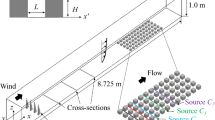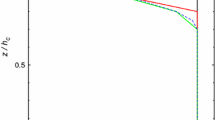Abstract
Two-point space-time correlations ofvelocities, a passive scalar and static pressure arecalculated using the resolvable flow fields computedby large-eddy simulation (LES) of neutrally stratifiedflow within and above a sparse forest. Zero-time-lagspatial auto-correlation contours in thestreamwise-vertical cross-section for longitudinal andlateral velocities and for a scalar are tilted fromthe vertical in the downstream direction, as istypical in near-wall sheared flow. On the other hand,auto-correlations of vertical velocity and of staticpressure are vertically coherent. Zero-time-lagspatial auto-correlations in the spanwise-verticalcross-section show no distinct tilt, and those forboth longitudinal and vertical velocities demonstratedistinct negative side lobes in the middle forest andabove, while longitudinal velocity in the subcrowntrunk space is laterally in-phase. Static pressureperturbations appear to be spatially coherent in thespanwise direction at all heights, especially insidethe forest. Near the forest floor, longitudinalvelocity is found to be in-phase with static pressureperturbation and to be closely linked to theinstantaneous streamwise pressure gradient, supportinga previous proposal that longitudinal velocity in thisregion is dominantly modulated by the pressurepatterns associated with the coherent sweep/ejectionevents. Near treetop height, a lack of linkage betweenthe pressure gradient and the local time derivative ofthe longitudinal velocity supports the hypothesis ofadvection dominating turbulent flow.
The major phase characteristics of the two-pointcorrelations essentially remained the same from fourLES runs with different domain size and/or gridresolution. A larger LES domain yielded betteragreement with field observations in a real forest onboth the magnitudes of the correlations and thesingle-point integral time scales. A finer gridresolution in the LES led to a faster rate of decreaseof correlation with increasing separation in space ortime, as did the higher frequency fluctuations in theturbulent records from field measurements. Convectivevelocities estimated from the lagged two-pointauto-correlations of the calculated flow fields werecompared with similar calculations from wind-tunnelstudies. At the canopy top, estimates from thecorrelation analyses agree with the translationvelocity estimated from instantaneous snapshots of ascalar microfront using both LES and field data. Thistranslation velocity is somewhat higher than the localmean wind speed. Convective velocities estimated fromlagged correlations increase with height above thecanopy. It is suggested that an appropriate filteringprocedure may be necessary to reduce the effects ofsmall-scale random turbulence, as was reported in astudy over an orchard canopy. The mean longitudinalvelocity near the treetops is found to be moreappropriate than the local mean longitudinal velocityat each height to link single-point integral timescales with directly calculated spatial integralstreamwise length scales.
Similar content being viewed by others
Author information
Authors and Affiliations
Rights and permissions
About this article
Cite this article
Su, HB., Shaw, R.H. & Paw U, K.T. Two-Point Correlation Analysis Of Neutrally Stratified Flow Within And Above A Forest From Large-Eddy Simulation. Boundary-Layer Meteorology 94, 423–460 (2000). https://doi.org/10.1023/A:1002430213742
Issue Date:
DOI: https://doi.org/10.1023/A:1002430213742




